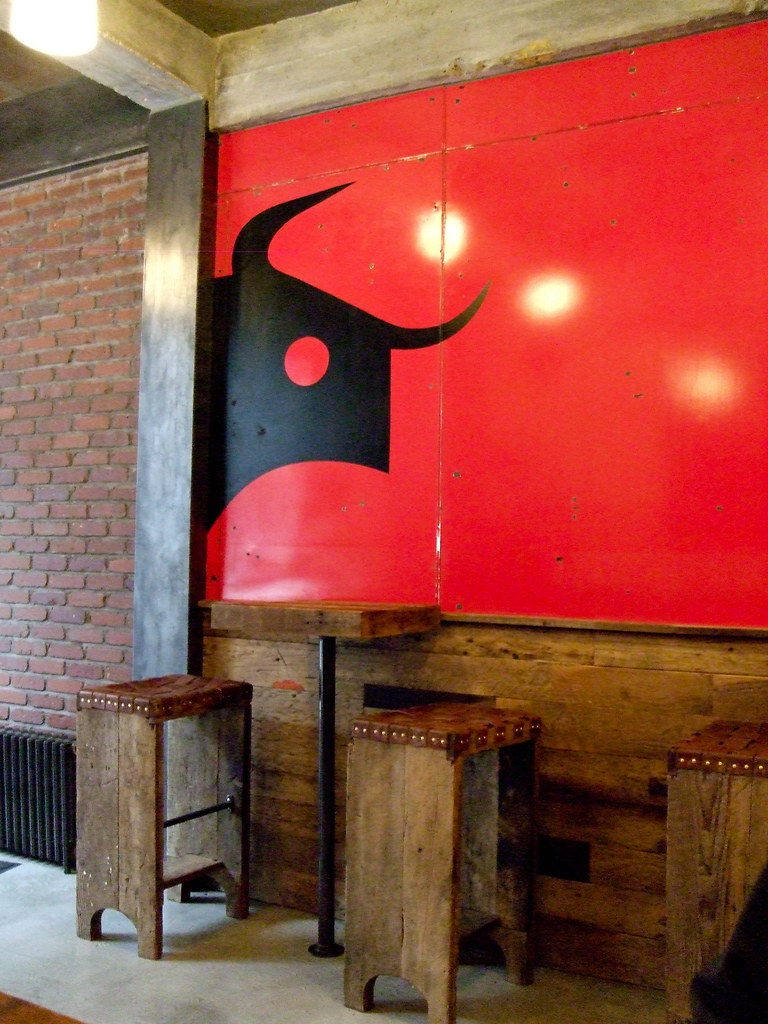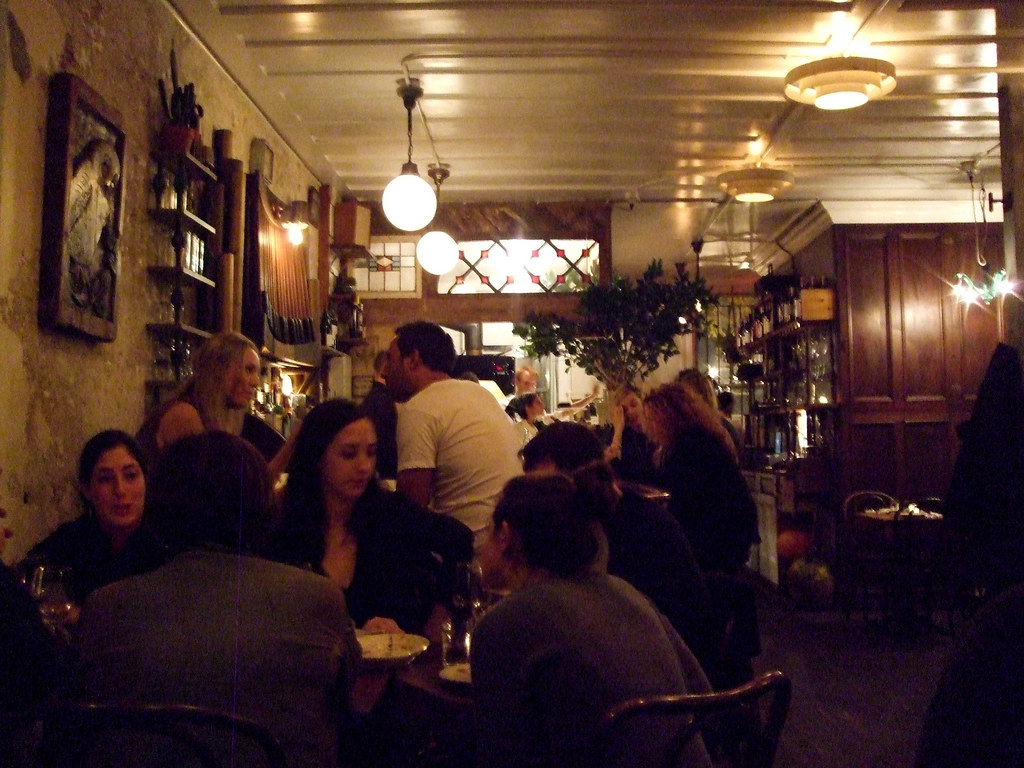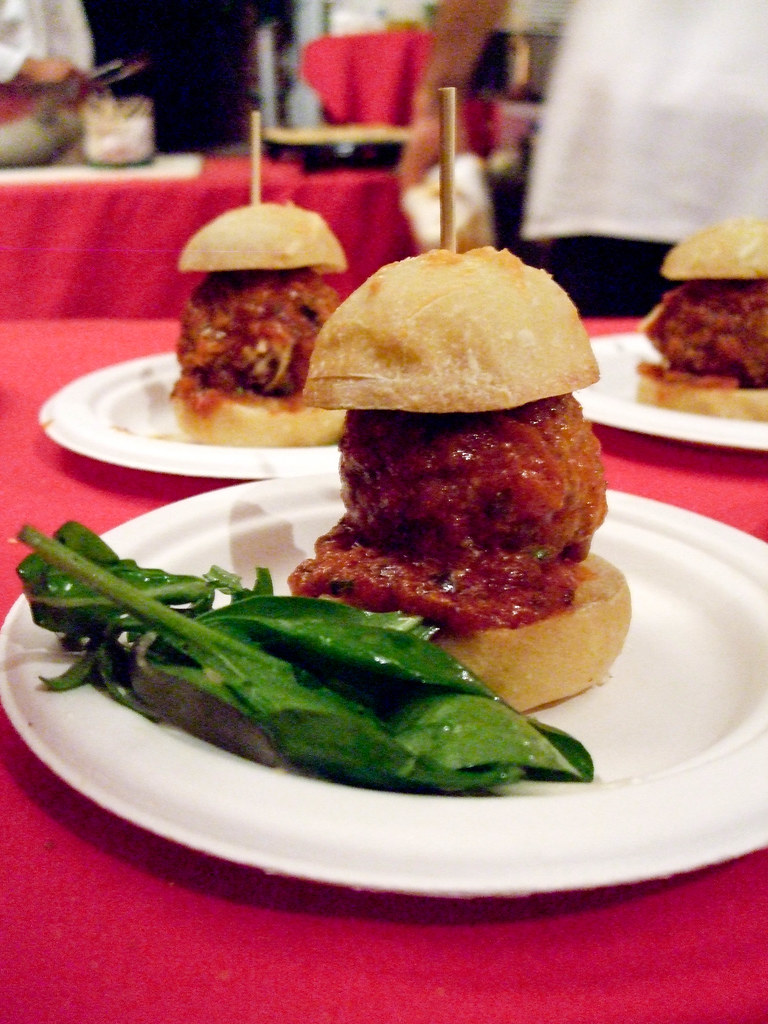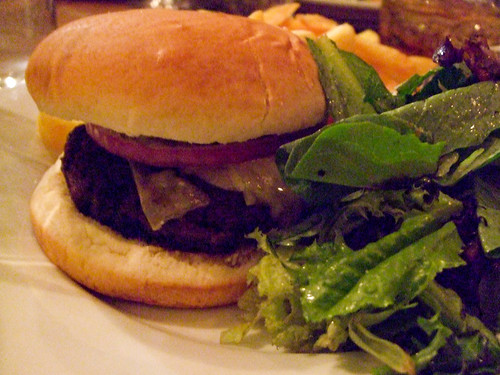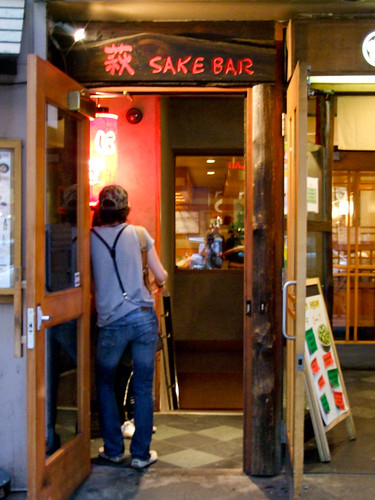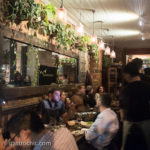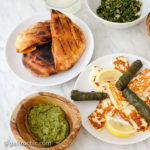Tag Archives: beef
Lunch: Dos Toros
No matter how much New Yorkers try to claim their city’s superiority in various areas—culture, music, fashion, 24-hour delivery of anything you desire—there is one category in which we must concede defeat: availability of good, authentic Mexican food. California has always had us beat in this department. It’s not that we are unaware of the problem. It’s just that, like many great quandaries of the day, we don’t know how to fix it.
Fortunately, two brothers from San Francisco, Leo and Oliver Kremer, arrived in the city determined to recreate Mission-style Mexican here in New York. The new Dos Toros taqueria near Union Sqare provides a much-needed upgrade to the Mexican food situation in Manhattan, which, unlike Brooklyn and Queens, hasn’t benefited from the recent uptick in good taquerias. (more…)
Vinegar Hill House
Dumbo: It used to be the kind of place where women didn’t walk alone at night, artists and musicians got home just as day laborers were waking up, and the only place to eat was Pedro’s, though you wouldn’t necessarily want to eat there, either. The nearest deli was in Brooklyn Heights, and there were no grocery stores. You could get a deal living in an old graffiti’d gun factory, if you were willing to rig up your own electric heating system and build your own bedroom wall. The streets were empty, the views were spectacular, and no one else knew where the hell it was.
Fast forward thirteen years to now: “Dumbo,” a woman in a silk wrap said into her cell phone in the middle of Vinegar Hill House the other night. “The neighborhood is called Dumbo.” A half hour later, her friends arrived. (more…)
Le Relais de Venise L’Entrecote
“It’s like the Ray’s Pizza of Paris,” I said to Marie Fromage, trying to describe the complicated history of L’Entrecôte. “There are several of them, and each one claims to be ‘the original.’”
Unlike New York’s various “original” Ray’s Pizza shops, however, all of the L’Entrecôtes of Paris dish out steak frites with a delicious mystery sauce from the same grandfather’s recipe—they are just owned by different branches of the same Gineste de Saurs family. They all have a rabid following in Paris, though there is some debate as to which one is “the best.” Now L’Entrecôte is finally in New York.
The one off note that kept us from going until now was the location. The Le Relais de Venise L’Entrecôte, with locations in Paris and Barcelona, landed on the bottom floor of a brutish Midtown office building, a far cry from its charming centuries-old building in the 17th arrondissement. Inside, New York’s L’Entrecôte is cheerful, with bright lighting, as in Paris, a mural of Venice on the wall, as in Paris, banquettes, glass partitions, and no bar, also as in Paris. Once you’re inside, the most jarring difference is the absence of a thick haze of cigarette smoke floating above the tables – that and the fact that there are no lines or hour-long waits. We walked right in with a party of five and were seated immediately. (more…)
NYC Wine & Food Festival: Meatball Madness!
Dozens of NYC’s top chefs gathered on Sunday to turn out their best meatballs for the Meatball Madness event. A $5,000 prize was at stake, with proceeds from the event benefitting the Food Bank for New York City and Share Our Strength.
Here’s one sample of the deliciousness: Joey Campanaro’s meatball sliders for Little Owl. More meatballs and a video of the winner, after the jump. (more…)
NYC Wine & Food Festival: Tour de Beef
You can taste the difference between an aged cut of beef and a supermarket steak, but what exactly goes into the aging process? DeBragga and Spitler, one of the few remaining butchers in the Meatpacking District with a facility that ages millions of dollars of beef, let a few of the curious in to witness the process, and Marie Fromage was one of them.
 photo via Marie Fromage
photo via Marie Fromage
Turns out that aging beef is a lot like aging cheese, with elements like temperature, humidity, and bacteria working over a specific period of time to yield the desired results. As you might have guessed, the main difference between wet aged beef, the sort you find in supermarkets, and dry aged beef, the sort you find in a steakhouse, is the expense: Up to 50 percent of the dry aged beef product can be lost due to water loss and trimming of the less attractive aged bits. Mary Connolly a.k.a. Marie Fromage gives some details on the aging process, after the jump. (more…)
The Copycat Chef: Rosemary Beef Kebabs With Greenmarket Vegetables
The death of The Silver Palate‘s Shelly Lukins marks the end of an era: she and her partner Julee Rosso taught so many of us how to cook. They developed simple but sophisticated recipes for entertaining and introduced American cooks to bright Mediterranean flavors. Before the Silver Palate, garlic was considered exotic, and you couldn’t find fresh herbs at fancy supermarkets; now both are readily available nearly everywhere.
It was with their recipe for rosemary beef skewers in mind that I started working on this recipe several weeks ago. The marinade has been toned down – no more Asian influences of soy sauce and sesame oil – and the focus is on the herbs and greenmarket vegetables. If it hadn’t been for The Silver Palate, who knows if food would have evolved the way it has. (more…)
Lunch: Defonte’s of Brooklyn
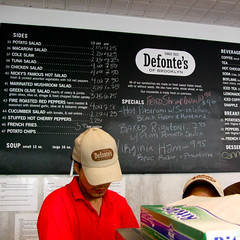 There are a lot of good things coming out of Brooklyn these days, not least of which is Defonte’s sandwich shop. The only drawback to the first Defonte’s was its location in Red Hook, too far away for most of us to get there for lunch. But there’s a reason for that other than the trendiness of Red Hook: Nick Defonte came over from Italy and worked in Red Hook as a longshoreman before starting up his sandwich shop there in 1922.
There are a lot of good things coming out of Brooklyn these days, not least of which is Defonte’s sandwich shop. The only drawback to the first Defonte’s was its location in Red Hook, too far away for most of us to get there for lunch. But there’s a reason for that other than the trendiness of Red Hook: Nick Defonte came over from Italy and worked in Red Hook as a longshoreman before starting up his sandwich shop there in 1922.
Now Defonte’s of Brooklyn has opened on Third Avenue and 21st in a modern, prime corner space with a stainless steel counter and a few granite tables, bringing their specialty hot sandwiches to the Manhattan work force. (more…)
More Burger Tips
As we head into the holiday weekend, the Times Dining section has a handy article on how to grill burgers. Some of the pointers, from 30 chefs with major burger cred, echo the ones in this earlier Gastro Chic article on what not to do when grilling burgers. Some are good new tips.
The final burger recipe is pretty unrealistic for a home chef, however, since it involves searing the burgers on a grill then finishing them in the oven. Most people’s outdoor grill is nowhere near their indoor oven. Also, I’ve noticed that guests tend to freak out if you abscond with a whole tray full of burgers. (more…)
Grilling Burgers: What Not to Do
This hilarious bad review of RF O’Sullivan’s in Boston by A Hamburger Today reminded me: there are so many people that don’t know how to cook a burger. Why? Because it’s not as easy as it seems. Once you clear away several widely-held misconceptions, however, it gets a lot easier.
- Do not use any kind of “lean” ground beef. “Lean” ground chuck is to meat what Snackwells are to cookies: blasphemy. There’s no need to be afraid of the fat in regular ground chuck. When you are cooking the meat, the fat heats up and liquifies, running out of the burger and leaving a much airier texture behind. Lean meat, on the other hand, results in dense, less flavorful burgers. Remember: fat is the conduit of flavor.*
- Don’t buy gourmet buns. Gourmet rolls, as mentioned in this review, tend to be too crusty and hard for a sandwich. The bun should meld to the burger. You’re better off with regular old sesame seed buns. (more…)
Monkey Bar
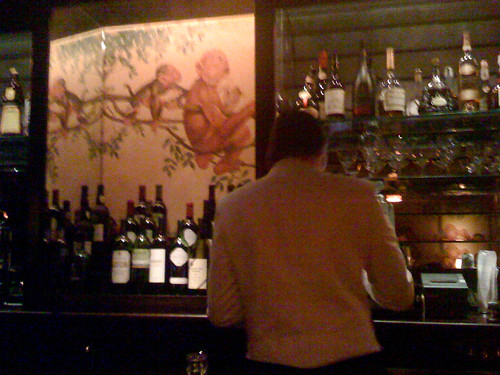 Back in the mid-’90s, when investment banking ruled the day, Monkey Bar was the place to see and be seen. There was a certain type of guy who gravitated here – the one who would wear his Brooks Brothers suit and Hermes tie out at 11pm rather than change. But on a recent late night, a group of white collar guys who huddled around their beers were stripped down to their undershirts – a suit isn’t exactly the badge of pride it used to be.
Back in the mid-’90s, when investment banking ruled the day, Monkey Bar was the place to see and be seen. There was a certain type of guy who gravitated here – the one who would wear his Brooks Brothers suit and Hermes tie out at 11pm rather than change. But on a recent late night, a group of white collar guys who huddled around their beers were stripped down to their undershirts – a suit isn’t exactly the badge of pride it used to be.
Is it strange that Monkey Bar of all places has been resuscitated now? Perhaps, but if anyone who could get glamorous media types and bankers together in Midtown, it would be Graydon Carter. (more…)
Bobo
 It’s hard to be taken seriously with a name like “bobo.” Wharton business major Carlos Suarez found he kept using the word, coined by David Brooks, when describing his plans for a new restaurant. Only a Wharton business major or Mary-Kate Olsen wouldn’t pick up on the inherent insult in a word that means “half yuppie-bourgeois and half hippie-bohemian.” No matter: Like Mary-Kate Olsen and many a business major, bobo succeeds anyway.
It’s hard to be taken seriously with a name like “bobo.” Wharton business major Carlos Suarez found he kept using the word, coined by David Brooks, when describing his plans for a new restaurant. Only a Wharton business major or Mary-Kate Olsen wouldn’t pick up on the inherent insult in a word that means “half yuppie-bourgeois and half hippie-bohemian.” No matter: Like Mary-Kate Olsen and many a business major, bobo succeeds anyway.
If you’ve been before and dismissed bobo because of the lackluster food, it’s worth a revisit. Former chef Nicholas Cantrel left and has since been installed at Bagatelle. In his place are chefs Rick Jakobsen from Red Hook’s 360 and Jared Stafford-Hill of Hearth. How convenient! All this time I’ve been to lazy to schlep out to the famously good 360, now tragically closed. One can only hope that the new incarnation of bobo can channel what was before out in Brooklyn’s Red Hook.
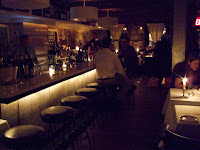 If you can find this nearly-unmarked West Village townhouse, you’ll walk into a beautiful, low-ceilinged, candlelit English basement level space with exposed beams, a long bar upholstered with a houndstooth pattern, and a black upright piano stacked with vintage LP records. They may be bobo touches all, but the records aren’t just for show. We heard the Beatles and Led Zeppelin the night we were there, complete with a few pops and scratches and the uncompressed, rich sound of old vinyl records.
If you can find this nearly-unmarked West Village townhouse, you’ll walk into a beautiful, low-ceilinged, candlelit English basement level space with exposed beams, a long bar upholstered with a houndstooth pattern, and a black upright piano stacked with vintage LP records. They may be bobo touches all, but the records aren’t just for show. We heard the Beatles and Led Zeppelin the night we were there, complete with a few pops and scratches and the uncompressed, rich sound of old vinyl records.
 It’s an appropriate soundtrack for a place that strives to keep it real, as much as a bourgeois bohemian can. Bobo is one of a growing number of restaurants that, for environmental reasons, does not offer bottled water. Instead, they make their own purified and seltzer water and serve it in carafes.
It’s an appropriate soundtrack for a place that strives to keep it real, as much as a bourgeois bohemian can. Bobo is one of a growing number of restaurants that, for environmental reasons, does not offer bottled water. Instead, they make their own purified and seltzer water and serve it in carafes.
It was a lively gang that night, perhaps because Knucklehead, Menudo, and Annette had already spent several hours at Smith & Mills before heading uptown. High Maintenance ordered the winter squash soup with pear, cranberry, and smoked duck – hold the pear, cranberry, and smoked duck (don’t ask). The spartan soup that remained held up well on its own, however, and it came served in pretty vintage bone china.
 My tuna, white bean and arugula salad arrived as a salad alongside a massive hunk of tuna that must have been prepared in some high-tech way. Was it grilled then sous-vide’d? Grilled then preserved in a crystallized format somehow? Either way, the resulting tuna, though visually appealing, was oddly rubbery and bland. As Sara Jenkins pointed out, why do male chefs insist on treating the kitchen like a science lab? But the white beans were wonderfully toothsome and the arugula nice and peppery.
My tuna, white bean and arugula salad arrived as a salad alongside a massive hunk of tuna that must have been prepared in some high-tech way. Was it grilled then sous-vide’d? Grilled then preserved in a crystallized format somehow? Either way, the resulting tuna, though visually appealing, was oddly rubbery and bland. As Sara Jenkins pointed out, why do male chefs insist on treating the kitchen like a science lab? But the white beans were wonderfully toothsome and the arugula nice and peppery.
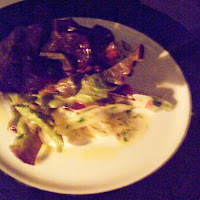 Menudo’s winter vegetable salad was exactly as advertised and came with a delicately tangy lemon dressing. Raw scallops and grapefruit, beets, and fennel came together in Knucklehead’s dish, the best of the appetizers.
Menudo’s winter vegetable salad was exactly as advertised and came with a delicately tangy lemon dressing. Raw scallops and grapefruit, beets, and fennel came together in Knucklehead’s dish, the best of the appetizers.  The scallops had a wonderfully clean, barely saline taste, delicious with the bitter sweet juicy crunch of the grapefruit. As we saw at Momofuku Ssam, scallops pair particularly well with fruit, and a sprinkling of fennel leaves gave Bobo’s a tingling herbal taste.
The scallops had a wonderfully clean, barely saline taste, delicious with the bitter sweet juicy crunch of the grapefruit. As we saw at Momofuku Ssam, scallops pair particularly well with fruit, and a sprinkling of fennel leaves gave Bobo’s a tingling herbal taste.
 Surprisingly for a place that’s not even Italian, much less a serious pasta joint, Bobo has a ricotta ravioli that could contend with the best. Huge, plump, generously portioned ravioli were already decadent before getting dressed in butter, parmesan, and meltingly soft winter vegetables.
Surprisingly for a place that’s not even Italian, much less a serious pasta joint, Bobo has a ricotta ravioli that could contend with the best. Huge, plump, generously portioned ravioli were already decadent before getting dressed in butter, parmesan, and meltingly soft winter vegetables.
 The chicken was just the sort of elevated comfort food we were craving on that rainy night. Crispy skin, tender meat, and a buttery flavor throughout. It had been seasoned just enough, but not too much to overwhelm the rich flavor. A mixture of polenta and black cabbage topped off the homeyness of the dish.
The chicken was just the sort of elevated comfort food we were craving on that rainy night. Crispy skin, tender meat, and a buttery flavor throughout. It had been seasoned just enough, but not too much to overwhelm the rich flavor. A mixture of polenta and black cabbage topped off the homeyness of the dish.
 Supposedly there was a basic steak dish at the previous incarnation of Bobo, which I never visited. The current entree takes steak to the next level, topping it with oxtail soffrito and caramelized cippolini. Here again Bobo straddles the line between comforting and outright decadent and succeeds with flying colors.
Supposedly there was a basic steak dish at the previous incarnation of Bobo, which I never visited. The current entree takes steak to the next level, topping it with oxtail soffrito and caramelized cippolini. Here again Bobo straddles the line between comforting and outright decadent and succeeds with flying colors.
 Pot au feu gets a tweak with lamb substituted for beef as the starring meat. I can’t imagine why I’ve never seen this dish before in a New York restaurant. Lamb makes the pot au feu so much more flavorful, and the vegetables were still al dente, done in the Dan Barber haute barnyard style.
Pot au feu gets a tweak with lamb substituted for beef as the starring meat. I can’t imagine why I’ve never seen this dish before in a New York restaurant. Lamb makes the pot au feu so much more flavorful, and the vegetables were still al dente, done in the Dan Barber haute barnyard style.
There are so many iterations of Annette’s Berkshire pork entree with cabbage, potatoes, and pinot gris in the city now that it was hard to set this one apart, but his had prettily carved baby potatoes in the French style.
 As for the desserts, we wished the chocolat pot de creme had gelled a little bit more – it should be firm, not gloopy. But it was nice to see a good old-fashioned upside down cake, this time in
As for the desserts, we wished the chocolat pot de creme had gelled a little bit more – it should be firm, not gloopy. But it was nice to see a good old-fashioned upside down cake, this time in pear, on an urban menu again. Definitely worth the post-prandial calories.
pear, on an urban menu again. Definitely worth the post-prandial calories.
 A trip to the restroom revealed a gorgeous second floor dining room on the townhouse’s parlor floor. All the details have been well thought-out here, from the octagonal book nooks to the dramatic chandeliers to the Victorian wallpaper and brass swan fixtures in the powder room. Now, it seems, bobo’s food is finally following suit. If liking Bobo makes one bobo, then consider me guilty as charged.
A trip to the restroom revealed a gorgeous second floor dining room on the townhouse’s parlor floor. All the details have been well thought-out here, from the octagonal book nooks to the dramatic chandeliers to the Victorian wallpaper and brass swan fixtures in the powder room. Now, it seems, bobo’s food is finally following suit. If liking Bobo makes one bobo, then consider me guilty as charged.
 bobo
bobo
181 West 10th Street at Seventh Avenue South
New York, New York
212-488-2626
Dovetail
Normally I don’t even try to go to popular new restaurants on the Upper West Side, considering it an exercise in futility. I could never get a table at ‘Cesca when Tom Valenti was cooking, and by the time I got to Aix, it could have been called “eh.” It might be the Upper West Sider’s uncanny ability to plan ahead – all that booking of Met and Carnegie Hall tickets – but here’s another theory why, with apologies to Jessica Hagy of Indexed.

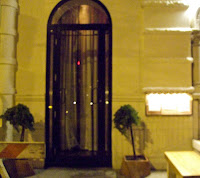 Dovetail aims to be a neighborhood place: the side street location on the ground floor of a limestone townhouse in the West 70’s makes that clear. But this new place by chef John Fraser shouldn’t be the property of neighborhood residents alone. Run, don’t walk, to Dovetail before the entire city is flocking to the Upper West Side for this fantastic new restaurant.
Dovetail aims to be a neighborhood place: the side street location on the ground floor of a limestone townhouse in the West 70’s makes that clear. But this new place by chef John Fraser shouldn’t be the property of neighborhood residents alone. Run, don’t walk, to Dovetail before the entire city is flocking to the Upper West Side for this fantastic new restaurant.
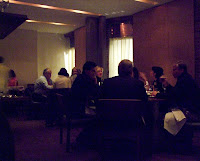 The only things keeping this from N.F.P. status may be the decor. Sleek to the point of moody minimalism, done in shades of gray, brown, and browngray, Dovetail reminded me of a starkly decorated residence of a lifelong bachelor, the kind who would rather unplug and move one lamp from bedroom to living room rather than buy an extra lamp, much less artwork (true story). Muted moss green chairs are as exciting as it gets.
The only things keeping this from N.F.P. status may be the decor. Sleek to the point of moody minimalism, done in shades of gray, brown, and browngray, Dovetail reminded me of a starkly decorated residence of a lifelong bachelor, the kind who would rather unplug and move one lamp from bedroom to living room rather than buy an extra lamp, much less artwork (true story). Muted moss green chairs are as exciting as it gets.
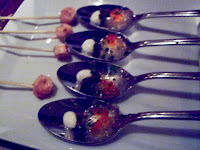 Canada, the Master Orderer, Marie Fromage and I were greeted with amuse bouches of caviar, fried capers, sour cream, and vodka gelee. Very decadent, like something out of the Master and Margarita, and the vodka added an intriguing, slightly bitter element to the salty-creamy mix.
Canada, the Master Orderer, Marie Fromage and I were greeted with amuse bouches of caviar, fried capers, sour cream, and vodka gelee. Very decadent, like something out of the Master and Margarita, and the vodka added an intriguing, slightly bitter element to the salty-creamy mix.
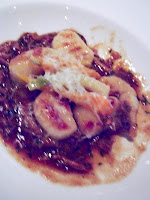 As expected, the Master Orderer triumphed with his choice of the gnocchi with veal short ribs, foie gras butter, and prunes. The gnocchi were light and retained just a hint of riced-potato texture inside. Veal short ribs turn out to be a very meaty but elegant cut, not as fatty as beef short ribs. The sauce was significantly richened by the foie gras butter. Though the food here could be called “New American,” Fraser’s use of French technique significantly deepens the experience.
As expected, the Master Orderer triumphed with his choice of the gnocchi with veal short ribs, foie gras butter, and prunes. The gnocchi were light and retained just a hint of riced-potato texture inside. Veal short ribs turn out to be a very meaty but elegant cut, not as fatty as beef short ribs. The sauce was significantly richened by the foie gras butter. Though the food here could be called “New American,” Fraser’s use of French technique significantly deepens the experience.
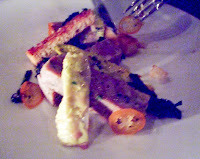 As with the veal short rib sauce, he often takes a familiar recipe and turns it up a notch by refining the key ingredients in the mix. Terrine was made not with pork but with rabbit – again a leaner, lighter meat that takes this countrified dish up a notch. Perfectly seasoned and ground, the terrine was also at the right temperature – not too cold, just slightly cooler than room temperature either. A too-cold country pate reminds me of leftover meatloaf straight from the fridge – not good.
As with the veal short rib sauce, he often takes a familiar recipe and turns it up a notch by refining the key ingredients in the mix. Terrine was made not with pork but with rabbit – again a leaner, lighter meat that takes this countrified dish up a notch. Perfectly seasoned and ground, the terrine was also at the right temperature – not too cold, just slightly cooler than room temperature either. A too-cold country pate reminds me of leftover meatloaf straight from the fridge – not good.
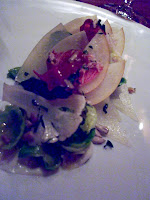 The mildest of the appetizers, the brussels sprouts leaves salad, was lightly citrusy, an elegant winter salad with a nice crunch and a smattering of prosciutto and pears.
The mildest of the appetizers, the brussels sprouts leaves salad, was lightly citrusy, an elegant winter salad with a nice crunch and a smattering of prosciutto and pears.
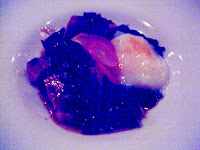 After the veal gnocchi, our other favorite appetizer was the pork belly, maitake mushrooms, kale, and egg, which the menu calls a “hen egg” (as opposed to a rooster egg?). I love a coddled egg, and here it was sandwiched next to kale that had been brought to the point of nori-like crispiness. Mixed with the succulent pork belly, the whole thing was a fabulous conflation of flavors.
After the veal gnocchi, our other favorite appetizer was the pork belly, maitake mushrooms, kale, and egg, which the menu calls a “hen egg” (as opposed to a rooster egg?). I love a coddled egg, and here it was sandwiched next to kale that had been brought to the point of nori-like crispiness. Mixed with the succulent pork belly, the whole thing was a fabulous conflation of flavors.
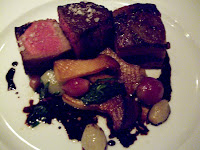 Moving on, we managed to order all meat courses, though there are some excellent fish choices on the menu as well, including the requisite fish-n-bacon combo. The Master Orderer – we must always check in with this bellwether first – went for the roasted sirloin and beef cheek lasagna. Here’s another food trend I’m liking: serving up the animal in various incarnations (apologies to Buddhists). In this case, the nicely aged and grilled sirloin was better than the lasagna, which was actually just mushrooms and beef cheeks stacked to resemble lasagna – gyp.
Moving on, we managed to order all meat courses, though there are some excellent fish choices on the menu as well, including the requisite fish-n-bacon combo. The Master Orderer – we must always check in with this bellwether first – went for the roasted sirloin and beef cheek lasagna. Here’s another food trend I’m liking: serving up the animal in various incarnations (apologies to Buddhists). In this case, the nicely aged and grilled sirloin was better than the lasagna, which was actually just mushrooms and beef cheeks stacked to resemble lasagna – gyp.
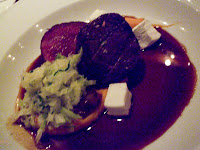 Each of our entrees – the sirloin, the grilled venison, the pistachio crusted duck, and the rack and leg of lamb – was notable for the quality of the meat itself and the wonderful sauces, which seemed to have a demiglace base. That night we didn’t have the problem that Alan Richman had of the meat being dried out – quite the opposite. Too often now not enough attention is paid to the star player on the plate, and restaurants just hope you get swept up by the sides, as I sometimes do. But even without the chestnuts, tangy-sweet stewed cabbage, and cute little marshmallows that decorated the plate, the cut of slightly smoky, tender venison itself would have been a star.
Each of our entrees – the sirloin, the grilled venison, the pistachio crusted duck, and the rack and leg of lamb – was notable for the quality of the meat itself and the wonderful sauces, which seemed to have a demiglace base. That night we didn’t have the problem that Alan Richman had of the meat being dried out – quite the opposite. Too often now not enough attention is paid to the star player on the plate, and restaurants just hope you get swept up by the sides, as I sometimes do. But even without the chestnuts, tangy-sweet stewed cabbage, and cute little marshmallows that decorated the plate, the cut of slightly smoky, tender venison itself would have been a star.
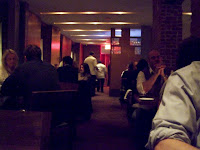 “Now that’s how venison is supposed to t
“Now that’s how venison is supposed to t
aste,” Marie Fromage said.
“I don’t get the marshmallows,” Canada said. Indeed, they were cutesy.
But the Master Orderer said, “Marshmallows are always good.”
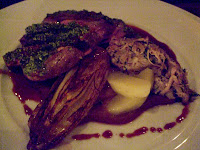 The pistachio-crusted duck was flavorful and bird-y, not gamey, the dish a refined French preparation that involved lots of beautiful slow roasted vegetables like endive.
The pistachio-crusted duck was flavorful and bird-y, not gamey, the dish a refined French preparation that involved lots of beautiful slow roasted vegetables like endive.
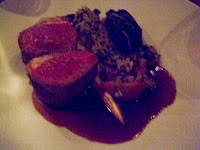 The menu description of “rack and leg of lamb” with “Indian spices, winter tabouleh, and yogurt” conjured up a very specific idea. A whiff of the exotic, plus the comfort of the known, with the enticement of tabouleh reinterpreted for a different season. One of the best things about Dovetail is that it delivers on your expectations and then some. The cut of lamb was so delicious and perfectly cooked to medium rare, the rub of spices so fragrant but unobtrusive, the hominy-like texture of the warm bulgur wheat tabouleh so good against the tang of yogurt. One bite and you’re transported away, maybe not as far as India, but at least as far as Morocco.
The menu description of “rack and leg of lamb” with “Indian spices, winter tabouleh, and yogurt” conjured up a very specific idea. A whiff of the exotic, plus the comfort of the known, with the enticement of tabouleh reinterpreted for a different season. One of the best things about Dovetail is that it delivers on your expectations and then some. The cut of lamb was so delicious and perfectly cooked to medium rare, the rub of spices so fragrant but unobtrusive, the hominy-like texture of the warm bulgur wheat tabouleh so good against the tang of yogurt. One bite and you’re transported away, maybe not as far as India, but at least as far as Morocco.
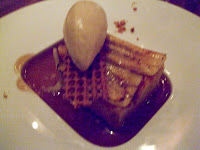 Fortunately the portion sizes are not overwhelming, because we still had room for dessert. The best was Canada’s order of the banana brioche with a bacon-flavored wafer. Don’t be afraid: there’s only a hint of bacon compared to the richness of the brioche. Delicious. Another good pick on that night’s dessert menu was the cheesecake ice cream.
Fortunately the portion sizes are not overwhelming, because we still had room for dessert. The best was Canada’s order of the banana brioche with a bacon-flavored wafer. Don’t be afraid: there’s only a hint of bacon compared to the richness of the brioche. Delicious. Another good pick on that night’s dessert menu was the cheesecake ice cream.
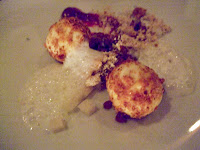 The only downfall of the night was weird little beet jelly petits fours presented at the end. Even if you were a beet fan. As Marie Fromage put it, “They’re trying to challenge you, and at this point of the night you don’t want to be challenged.”
The only downfall of the night was weird little beet jelly petits fours presented at the end. Even if you were a beet fan. As Marie Fromage put it, “They’re trying to challenge you, and at this point of the night you don’t want to be challenged.”
Prices were reasonable for this caliber of food, though the wine list does not feature enough bottles under $100. There’s a $125 tasting menu, including wine pairings, which I would do on a second visit. Service was very attentive and smooth, though we did have to wait forever for the check, and I think I terrified the waitress when I whipped out a camera to photograph the food. God knows why, since I am just a blogger, and they’ll probably have many more.
Afterwards we couldn’t say enough good things about this place. Canada and the Master Orderer are going back “with friends.” (What are we, chopped rabbit?!?) Let’s hope John Fraser will be considered for the 2008 Food & Wine Best New Chef awards. In the meantime, diners from all over the city should head to the Upper West while this great new restaurant is still in a very exciting stage – when the star chef is in the kitchen, cooking.
 Dovetail
Dovetail
103 West 77th Street between Columbus and Broadway
New York, New York
212-362-3800
Keens
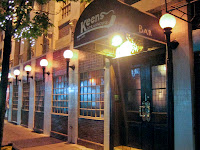 Burger blowhards are everywhere these days. Just as every Ray’s Pizza calls itself “the original,” every place that can scoop together a handful of ground meat and throw it on a grill likes to call their burger “the best.”
Burger blowhards are everywhere these days. Just as every Ray’s Pizza calls itself “the original,” every place that can scoop together a handful of ground meat and throw it on a grill likes to call their burger “the best.”
 After a disappointingly diminutive burger at Resto and a misfired one at Bar Marmont, I was getting ready to give up. A victim of false advertising, I actually believed Bar Marmont’s menu when it touted the restaurant’s own burger as a “darn good burger.” The presumptuousness in the name seems akin to Bruni’s pet peeve, wherein “eat” is interchangeable with “enjoy” in every waiter’s vocabulary. (“Are you done enjoying that?”) There’s also a fashion equivalent. A girl walking down Robertson Boulevard last month sported an outsize tee shirt that read “THIS IS WHY I’M HOT.” If you have to say so…
After a disappointingly diminutive burger at Resto and a misfired one at Bar Marmont, I was getting ready to give up. A victim of false advertising, I actually believed Bar Marmont’s menu when it touted the restaurant’s own burger as a “darn good burger.” The presumptuousness in the name seems akin to Bruni’s pet peeve, wherein “eat” is interchangeable with “enjoy” in every waiter’s vocabulary. (“Are you done enjoying that?”) There’s also a fashion equivalent. A girl walking down Robertson Boulevard last month sported an outsize tee shirt that read “THIS IS WHY I’M HOT.” If you have to say so…
 Then providence intervened in the form of Keens. High Maintenance, Fang Shui et al. ended up at Keens at the eleventh hour before a Bruce Springsteen show. The place was packed. We had no reservations. The maitre d’ was merciful. If we ordered quickly, we could be in and out of the wood paneled, clubby pub room before the Boss went on.
Then providence intervened in the form of Keens. High Maintenance, Fang Shui et al. ended up at Keens at the eleventh hour before a Bruce Springsteen show. The place was packed. We had no reservations. The maitre d’ was merciful. If we ordered quickly, we could be in and out of the wood paneled, clubby pub room before the Boss went on.
 If you don’t know Keens, you’re most likely female. Nearly every male in a fifty mile radius has been to historic Keens over the last 100 years. Not only are they famous for their steaks, they’re also known as a prime bachelor party destination. The ceilings are decorated with hundreds of clay pipes of bachelors past, when the place was a major hangout spot for gentlemen and actresses like “Miss Keens” in the nude portrait above the bar.
If you don’t know Keens, you’re most likely female. Nearly every male in a fifty mile radius has been to historic Keens over the last 100 years. Not only are they famous for their steaks, they’re also known as a prime bachelor party destination. The ceilings are decorated with hundreds of clay pipes of bachelors past, when the place was a major hangout spot for gentlemen and actresses like “Miss Keens” in the nude portrait above the bar.
Burgers can be wolfed down in a shorter time than steaks, so High Maintenance and I went for those. The “Lady Burger” is a sort of diet plate adaptation of the traditional burger, with no bun and sauteed potatoes instead of fries. This seemed interesting enough to try and showcased the meat itself, which had a deep, grassy flavor on par with aged sirloin, though it’s just prime beef chuck, very freshly ground.
 High Maintenance wisely ordered the regular cheeseburger and fortunately only ate half of it, so that I took other half. Finally – a great burger. Both burger and bun had a nice char from the grill. Cheddar cheese was melted to an oozy glaze. Technically, the burger was slightly smaller than the bun, but it’s so juicy that once you sandwich it together with crisp lettuce, tomato and red onion and saw the whole thing in half, it all melds into a coherent circle. Best of all, there was nothing weird about it. Chef Bill Rodgers saw no need to substitute a regular bun with some kind of hardened brioche or swap out cheddar for herbed goat cheese. Nothing kills a good burger like creativity. Chefs should go as wild as they want with other American classics like meatloaf or even pancakes, but please leave burgers alone.
High Maintenance wisely ordered the regular cheeseburger and fortunately only ate half of it, so that I took other half. Finally – a great burger. Both burger and bun had a nice char from the grill. Cheddar cheese was melted to an oozy glaze. Technically, the burger was slightly smaller than the bun, but it’s so juicy that once you sandwich it together with crisp lettuce, tomato and red onion and saw the whole thing in half, it all melds into a coherent circle. Best of all, there was nothing weird about it. Chef Bill Rodgers saw no need to substitute a regular bun with some kind of hardened brioche or swap out cheddar for herbed goat cheese. Nothing kills a good burger like creativity. Chefs should go as wild as they want with other American classics like meatloaf or even pancakes, but please leave burgers alone.
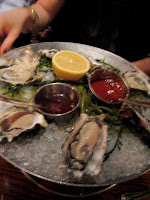 Other standout items on the Keens pub menu are the salty-sweet, plump oysters on the half shell, crisp, just slightly greasy fries, and the perfectly mixed martinis. This is one place that knows about kickin’ it old school.
Other standout items on the Keens pub menu are the salty-sweet, plump oysters on the half shell, crisp, just slightly greasy fries, and the perfectly mixed martinis. This is one place that knows about kickin’ it old school.
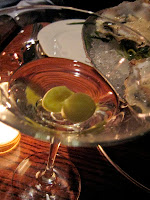 With all the burger places and gastropubs opening, it’s easy to forget that steakhouses are an excellent source for burgers. The pub room at Keens is better than a go-to place before a show or game at Madison Square Garden – it should be on every carnivore’s must-eat list.
With all the burger places and gastropubs opening, it’s easy to forget that steakhouses are an excellent source for burgers. The pub room at Keens is better than a go-to place before a show or game at Madison Square Garden – it should be on every carnivore’s must-eat list.
Keens Steakhouse
72 West 36th Street, between Fifth and Sixth Avenues
New York, New York
212-947-3636
Kuku Canteen
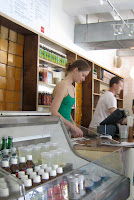 In the interest of full disclosure, it should be noted that I have a relationship with the restaurant featured in this review: The folks at Wawa Canteen prepare delicious food, and I eat it. Several times a week.
In the interest of full disclosure, it should be noted that I have a relationship with the restaurant featured in this review: The folks at Wawa Canteen prepare delicious food, and I eat it. Several times a week.
When a tiny Korean restaurant in central Greenwich Village closed a couple years back, neighbors were dismayed, expecting the usual NYU-geared smoothie/creperie/coffee shop to open in its place. But what arrived was Korean Restaurant 2.0, with a sleek design comprised of wood counters flanked by modern chairs, tiled walls and floors, and displays of rice and Sapporo lining the back wall. It’s now owned by Philip Rodrigue, who used to own the Cooler in the MPD. (He brought his excellent music collection with him.) What a relief to have an actual restaurant in this spot, and an approachable one, too. The ergonomic layout allows for quick service, because, as Rodrigue puts it, “You ought to be able to eat some decent food for $10 and be in and out in a half hour.”
Eureka. It’s the concept of a diner applied to ethnic food, in this case, Korean cuisine, which is underrepresented in New York compared to the plethora of Chinese, Japanese, and pan-Asian spots. Though Rodrigue says he was going for “generic eating,” the results are anything but. Consulting chef Donna Lee put a California spin on Korean food with home-cooking style dishes like surprisingly light kimchi fried rice.
 My first feeling upon biting into the kimchi fried rice with chicken was one of deep regret. Here I’d been eating at Wawa Canteen for nearly two years, and I’d never tried the best dish on the menu until now, in my quest to cover as many items as possible. The kimchi is so good – spicy, sweet, crunchy, tangy – and the sticky, fluffy rice has chili flecked throughout. Though this is traditional home cooking, the type you won’t find in Koreatown restaurant-style food, the presentation is elegant, with fine strips of nori on top. It’s exciting comfort food, and it can be habit-forming.
My first feeling upon biting into the kimchi fried rice with chicken was one of deep regret. Here I’d been eating at Wawa Canteen for nearly two years, and I’d never tried the best dish on the menu until now, in my quest to cover as many items as possible. The kimchi is so good – spicy, sweet, crunchy, tangy – and the sticky, fluffy rice has chili flecked throughout. Though this is traditional home cooking, the type you won’t find in Koreatown restaurant-style food, the presentation is elegant, with fine strips of nori on top. It’s exciting comfort food, and it can be habit-forming.
 Kimchi is an insanely popular ingredient here: during the NYU school year, Wawa goes through four 15-gallon vats of it in a week. Like a new pickle, Wawa’s kimchi retains that vegetable crunch that enlivens so many of the dishes here. The soft, barely sweet dough of the kimchi pajun is interlaced with strips of this crispy goodness, all of which goes beautifully with the slightly vinegary soy sauce.
Kimchi is an insanely popular ingredient here: during the NYU school year, Wawa goes through four 15-gallon vats of it in a week. Like a new pickle, Wawa’s kimchi retains that vegetable crunch that enlivens so many of the dishes here. The soft, barely sweet dough of the kimchi pajun is interlaced with strips of this crispy goodness, all of which goes beautifully with the slightly vinegary soy sauce.
 Of course, what kimchi also does is heat things up. Only the intrepid should opt for the kimchi stew, an incredibly spicy, sour concoction that blows away neighboring faux-Asian places whose food has too much sugar and not enough heat.
Of course, what kimchi also does is heat things up. Only the intrepid should opt for the kimchi stew, an incredibly spicy, sour concoction that blows away neighboring faux-Asian places whose food has too much sugar and not enough heat. 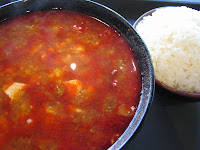 A red slick of chili oil on the soft tofu stew tells you this is one seafood dish that shouldn’t be taken lightly. Thankfully, the white rice served alongside helps put out the flames.
A red slick of chili oil on the soft tofu stew tells you this is one seafood dish that shouldn’t be taken lightly. Thankfully, the white rice served alongside helps put out the flames.
 If you can’t take the heat, never fear. Several dishes offer up healthy, vegetable-centric Korean food in a milder format. The best of the non-spicy bunch is the curry rice with chicken and vegetables. (Just ask for both chix and vegetables.) The rich sauce exudes a slow burn that complements the stewed potatoes, carrots, chicken, and beans.
If you can’t take the heat, never fear. Several dishes offer up healthy, vegetable-centric Korean food in a milder format. The best of the non-spicy bunch is the curry rice with chicken and vegetables. (Just ask for both chix and vegetables.) The rich sauce exudes a slow burn that complements the stewed potatoes, carrots, chicken, and beans.  Also tasty are the pork dumplings, soft little dollops whose sweetness is nicely cut by a vinegary black sauce. Ramen hits somewhere in between hot and mild; a hint of spice turns up the noodles a notch, and the pork in the pork ramen is plump and juicy.
Also tasty are the pork dumplings, soft little dollops whose sweetness is nicely cut by a vinegary black sauce. Ramen hits somewhere in between hot and mild; a hint of spice turns up the noodles a notch, and the pork in the pork ramen is plump and juicy.
 If you really want to go healthy, go for the soy ginger glazed chicken or the soy and ginger glazed chicken, definitely two of the lighter dishes on the menu. Both of these are barely dressed. The carb-avoidant could even eat just the protein and the very fresh sautéed bok choy and leave the rice behind. There are also plenty of vegetarian options on the menu.
If you really want to go healthy, go for the soy ginger glazed chicken or the soy and ginger glazed chicken, definitely two of the lighter dishes on the menu. Both of these are barely dressed. The carb-avoidant could even eat just the protein and the very fresh sautéed bok choy and leave the rice behind. There are also plenty of vegetarian options on the menu.
 Salads have true substance, like the cold buckwheat noodle salad topped with mixed greens and grilled soy-marinated steak, sliced razor-thin by a Korean purveyor. The dressings here – soy, citrus ginger, sesame – are delicious, and really make the ingredients pop.
Salads have true substance, like the cold buckwheat noodle salad topped with mixed greens and grilled soy-marinated steak, sliced razor-thin by a Korean purveyor. The dressings here – soy, citrus ginger, sesame – are delicious, and really make the ingredients pop.
 But the ultimate Korean dish is a mixture of spicy and mild, hot and cool, animal and vegetable: bibimbop. Wawa’s is a bonanza of hot soy-marinated beef, cold steamed spinach, bok choy, jullienned carrots, broccoli, bean sprouts, and rice, with a spicy red barbecue sauce served alongside. All the four food groups are well represented, except one. This is my one complaint about Wawa, and the first question I ever asked there: What about the egg?
But the ultimate Korean dish is a mixture of spicy and mild, hot and cool, animal and vegetable: bibimbop. Wawa’s is a bonanza of hot soy-marinated beef, cold steamed spinach, bok choy, jullienned carrots, broccoli, bean sprouts, and rice, with a spicy red barbecue sauce served alongside. All the four food groups are well represented, except one. This is my one complaint about Wawa, and the first question I ever asked there: What about the egg?
I’ll have to ask about it again next week.

Wawa Canteen
289 Mercer Street, between Waverly Place and 8th Street
New York, New York
212-473-6162
* Open Mon – Fri. Check website for hours.







